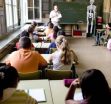(Press-News.org) EU farmers hold their own well in competition with the rest of the world, despite the comparatively high demands the EU places on agricultural production.
"We have investigated the connection between animal welfare regulation in the EU and competitiveness. We have seen that the impact on competitiveness and on trade is very minor, if it exists at all", says Anna Andersson, researcher at the AgriFood Economics Centre.
The aim of the report is to investigate whether trade barriers for certain products can be economically justified in order to protect a society's values. For example, should farmers who are required to comply with stricter animal welfare legislation be compensated so that consumers do not snub EU products?
"In the debate, it is often said that we cannot defend our own values at home, but the study does not support that view."
The cost of protecting domestic products, for example by introducing higher tariffs, is very high.
"More trade barriers would increase prices, consumers would have less choice, the use of our agricultural resources would become less efficient and reduced competition would lead to a less dynamic industry when the pressure for improvements falls. EU protection of agricultural products already hits poor countries the hardest and increased trade barriers would risk further worsening the situation", says Ms Andersson.
The EU has a negative trade balance, i.e. it imports more than it exports, and this is due to large imports of products such as bananas, coffee, salmon and prawns, which are not produced, or only produced on a small scale, within the Union.
###
The AgriFood Economics Centre is a collaboration between Lund University and the Swedish University of Agricultural Sciences.
Animal welfare does not damage competitiveness
2011-03-25
ELSE PRESS RELEASES FROM THIS DATE:
ICUROS study finds international variations in quality of life loss after fracture
2011-03-25
A study presented today at the European Congress on Osteoporosis and Osteoarthritis currently taking place in Valencia, Spain has found that the initial quality of life loss following an osteoporotic fracture is substantial, especially with regard to hip and vertebral fractures. The study found differences in quality of life loss between countries after correcting for other explanatory variables.
The quality of life (QoL) of patients who sustained a hip, wrist or vertebral fracture was examined for the four months following the fracture. The study is part of the International ...
Researchers: Sexually active teens need confidential health care
2011-03-25
After reviewing existing research regarding the common practices of health care providers who see adolescent patients across the country, Rebecca Allen, MD, MPH, a clinician and researcher at Women & Infants Hospital of Rhode Island, and her colleague, Michelle Forcier, MD, MPH, an adolescent medicine specialist at Hasbro Children's Hospital, asserted that the nation needs to offer more confidential care for teenagers who are sexually active.
This includes access to effective contraception, noted the doctors in the paper "Adolescent Sexuality and the Use of Contraception," ...
Military Personnel Caught With Spice and other 'Designer Drugs' Face Serious Consequences
2011-03-25
The Army, Navy, Air Force, and Marines are ramping up their efforts to go after military personnel using substances often called 'designer drugs.' In particular, the military Services are seeking to punish the use and trafficking in a chemical compound commonly referred to as Spice.
Marketed and sold as incense, Spice produces effects similar to marijuana when smoked. Until recently, the sale of Spice has been legal in all states. However, for those in the military, they must know that just because something is legally available for sale to civilians does not mean that ...
Uncertain future for Joshua trees projected with climate change
2011-03-25
FLAGSTAFF, Ariz. — Temperature increases resulting from climate change in the Southwest will likely eliminate Joshua trees from 90 percent of their current range in 60 to 90 years, according to a new study led by U.S. Geological Survey ecologist Ken Cole.
The research team used models of future climate, an analysis of the climatic tolerances of the species in its current range, and the fossil record to project the future distribution of Joshua trees. The study concludes that the species could be restricted to the northernmost portion of its current range as early as the ...
Inclusion of falls history shown to enhance accuracy of fracture risk assessment models
2011-03-25
Researchers from the MRC Lifecourse Epidemiology Unit in Southampton, UK, have presented a new study that shows how the inclusion of falls history, in addition to clinical risk factors (CRFs) and bone mineral density (BMD) values, would greatly improve the accuracy of fracture prediction models. The research findings were presented today at the European Congress on Osteoporosis & Osteoarthritis in Valencia, Spain.
Using results from the Hertfordshire Cohort Study, the investigators examined the relative contributions of CRFs, BMD and falls history to fracture prediction. ...
RIT researchers help map tsunami and earthquake damage in Japan
2011-03-25
Japan needs maps. Not just any kind—detailed informational maps georegistered with latitude and longitude and annotated with simple, self-evident details: this bridge is out, this port is damaged, this farm field is scoured; this one is verdant.
Researchers at Rochester Institute of Technology are processing satellite imagery of regions in Japan affected by the 9.0 magnitude earthquake and tsunami that devastated sections of the country's east coast on March 11. The U.S. Geological Survey, a member of the International Charter "Space and Major Disasters," organized the ...
Changing Misconceptions About Immigration
2011-03-25
When French president Nicolas Sarkozy recently declared that France's efforts at "multiculturalism" were a failure, it reminded those of us in the United States that we're not the only country in the world grappling with issues related to foreign immigration. But while European countries have tended to focus on the cultural side of the immigration debate, Americans are often focused on the perceived economic problems of immigration. As it turns out, Americans have less to worry about on both fronts than the current rhetoric might lead one to believe.
Economically, immigrants ...
Study: Teachers unaware of growing gender gaps in classrooms
2011-03-25
CHAMPAIGN, Ill. – A gap in reading and math scores still exists in lower grades, with boys continuing to outpace girls in math, and girls ahead of boys in reading, two University of Illinois education professors say.
Using national longitudinal data to perform their analysis, Joseph P. Robinson and Sarah Lubienski investigated male and female achievement in math and reading, looking for when gender gaps first appeared and where in the distribution the gaps were most prevalent.
Except for kindergarteners in the 99th percentile, boys and girls generally start out on equal ...
ATVs Remain Dangerous and Prone to Accidents, Crashes
2011-03-25
A recent death of a 12 year old in Florida highlights the danger inherent in the operation of All Terrain Vehicles (ATVs). Since their introduction in the early 1980s, ATVs have resulted in thousands of deaths and hundreds of thousands of emergency room visits.
While the designs have changed from the original 3-wheel, tricycle layout of the first Honda ATV, what hasn't changed is the danger posed by using these recreational vehicles. Since 1982, Florida has reported 447 deaths in connection with ATVs.
Nationwide, in the same period, at least 10,000 people have died ...
Around 25 percent of health messages in Spanish text books are not based on scientific evidence
2011-03-25
Most school text books contain messages about health, but 24.6% of these are not based on any scientific evidence, according to a study by the Knowledge Management Unit at Baza Hospital (Granada), published in the journal BMC Public Health.
"We analysed a total of 844 health messages in primary and secondary school text books in order to identify the level of scientific evidence underpinning these texts, and we classified them into three categories – messages with a high, medium or low level of evidence, messages with an unknown level of evidence, and messages with no ...


